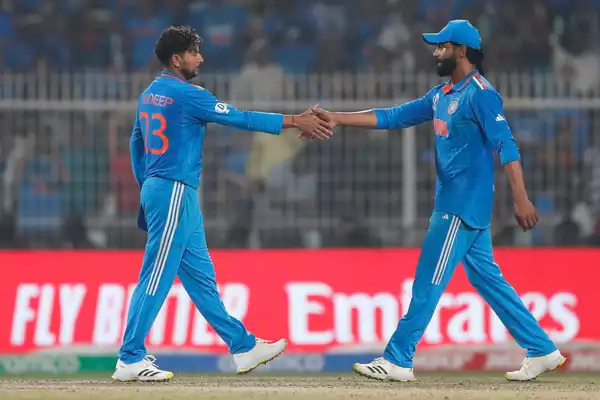
“Out-skilled” was the word South Africa’s head coach Rob Walter chose to use as he put things in perspective after a rather stunning loss against India. It’s a word that could perhaps be borrowed by any other opposition that has faced India in this tournament and still aptly sum up their predicament.
If there’s one thing that India have managed to get right, it’s their understanding of conditions and executing their skills, making it look as simple as withdrawing money from a fully loaded cash machine. They’ve played in a variety of conditions across the country, from red soil pitches to black soil to a mixture of the two; from flat surfaces to slow turners (like the one in Kolkata) and have found the people to deliver on them consistently. The pacers, deservedly, have got heads turning under the lights. But the collective aura would be diminished if it weren’t for the, as yet unheralded, contributions from their spinners.
In the sweltering heat of Chennai against Australia, India’s spin trio (the only time they played R Ashwin) gained a chokehold in the middle overs and picked up six wickets. Against Pakistan, Kuldeep Yadav and Ravindra Jadeja strung together crucial tight overs before a partnership broke and triggered a quick collapse. Against Bangladesh, a rare instance where the new ball didn’t yield wickets, the duo would share three of the top four wickets before the pacers had a middle-overs comeback. England and Sri Lanka would be decimated by the pace riches.
These instances offer a byte-sized encapsulation of how the spinners have enabled India to gather or enhance a chokehold. The latter was evident even against New Zealand, where Daryl Mitchell’s impressive footwork put Yadav under the pump. Going for 61 in his first seven overs, Yadav still offered India the middle overs breakthrough, giving away only 12 more in his last three and also picking up two wickets, thus supporting the comeback led by Mohammed Shami.
At the end of the South Africa game, India’s spinners collectively stood on top of all the key metrics amongst their peers. They had the most wickets (27), the best economy rate (3.92) and the best average (20.29). Their strike-rate of 31.0 was only behind Australia’s Adam Zampa-led S/R of 27.7.
It helps their cause that the team-management and captain have been on-point with reading the conditions, and tactics to be used. Before they came to Eden Gardens, incidentally the slowest scoring ground in the World Cup, Jadeja was always the fifth or sixth-bowling option. But with some turn from the straight and a slew of right-handers allowed Rohit to bring him in as the first-change, only to be proven right yet again.
Picking up five wickets, Jadeja believed that the amount of turn on the pitch had actually reduced from the afternoon. “Because if we had bowled in the afternoon, they might not have scored so many runs,” he said with much confidence in their spin skills.
The lead spinner now, Jadeja also revealed that he’s “always been thinking like a captain” at one point in his press conference. Like Rohit, and Rahul Dravid, pitch inspections are an unmissable part of Jadeja’s pre-game routine as well. Certain conditions such as Kolkata have been an ally for attack, but he’s been the lead in thrift otherwise, conceding at a frugal 3.77 an over — the best for any spinner playing more than a game in the tournament.
He’s had some help on that front. “See, always, in any format that you are playing, when your fast bowler takes 2-3 wickets from the top, it becomes easier for the spinner. Because a batsman who comes on slow wickets cannot play big shots straightaway. He needs time. And the spinner can bowl with more confidence,” he’d say and add, “He can bowl with speed and variation.”
Unhampered by the lack of dew largely so far in their outings, it’s in those skillsets that India has trampolined up from, inviting respect from even those falling prey to it.






